Previously: Frieze part 1: The fun of the fair.
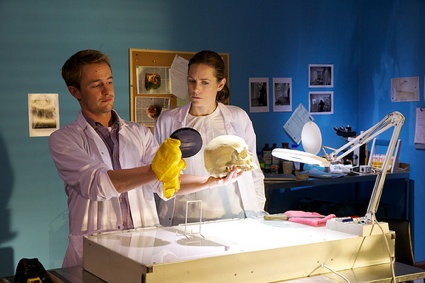 Asli Çavusoglu, Murder in Three Acts, 2012. Commissioned and produced by Frieze Foundation for Frieze Projects 2012. Photograph by Polly Braden
Asli Çavusoglu, Murder in Three Acts, 2012. Commissioned and produced by Frieze Foundation for Frieze Projects 2012. Photograph by Polly Braden
I review books about art, architecture, design and activism because that’s part of my job. It doesn’t hurt that i’m usually sent fantastic books. The only literature you will find on my kindle however is of the criminal kind: Stuart MacBride, Jo nesbø, Jussi Adler-Olsen, etc. The more gruesome the description, the more serial the killer, the happier i am.
Consequently, my favourite booth at the Frieze art fair a few weeks ago was La Central‘s. Its walls were covered with Carolina Caycedo’s 50 biro portraits of ‘Criminal Women’.
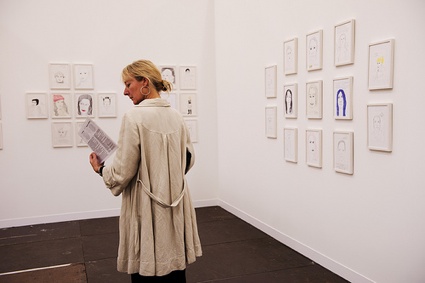 Carolina Caycedo, La Central, Bogota. Photograph by Linda Nylind
Carolina Caycedo, La Central, Bogota. Photograph by Linda Nylind
The drawings are of women found in newspapers, magazines, books and the Internet. In this work the artist explores an outsider construction of femininity through violence, deviancy, criminality, and radical politics in stark opposition to traditional notions of patriarchy.
Among the protagonists were: Lynndie England convicted in connection with the torture and prisoner abuse at Abu Ghraib prison in Baghdad, Lizzie Borden suspected of having killed her father and stepmother with an axe, Irma Grese who was employed at the concentration camps of Ravensbrück and Auschwitz where she picked out large breasted women and cut their breasts open with her whip, Fiona Mont aka “Britain’s Most Wanted Woman”, Griselda Blanco “La Madrina” (the Godmother) who was a drug lord for the Medellín Cartel, Sandra Ávila Beltrán the Mexican drug cartel leader nicknamed “La Reina del Pacífico”, sisters Teresa and Maria Zappia, leaders of Calabrian crime syndicate, Chinese Empress Dowager Tzu-hsi , etc.
For as long as i looked at their face and read the crude description of these women’s crimes, everything outside the booth ceased to exist for me. So much evil. Yet, because they were women or maybe because of the way they were drawn i never managed to see them as total monsters, Except that Irma Grese, the lady in high socks below:
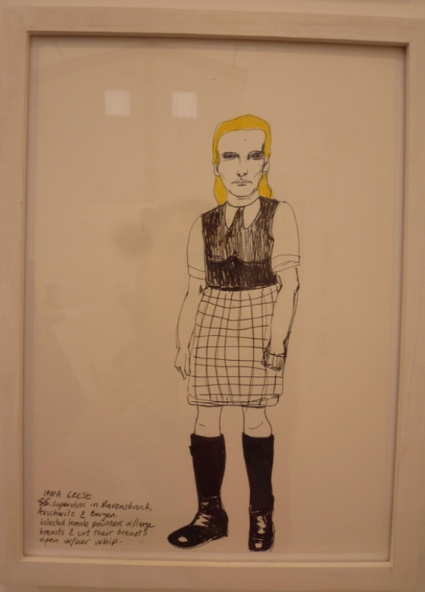
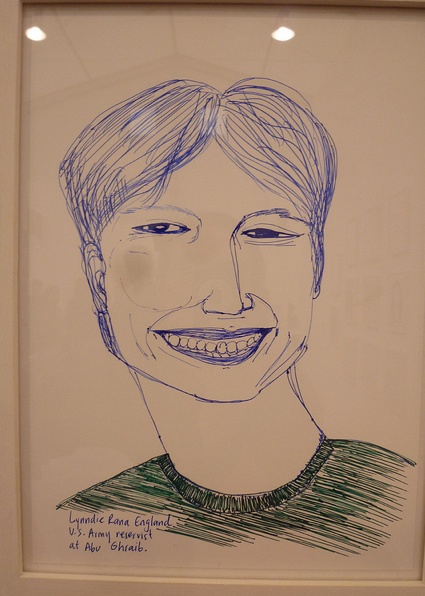
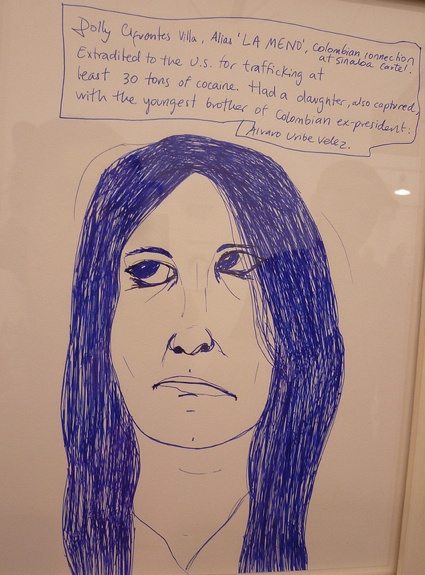
One of the Frieze commissions was part art gallery with blood on its walls and floor, part forensic lab, part video fiction. Aslı Çavuşoğlu and a professional crime drama crew and actors spent 3 days in a fairly small space shooting a crime and its forensic reconstitution.
Two of the main sources of inspiration for Murder in Three Acts were forensics and the representation of art in tv crime series. In some tv episodes indeed artworks aren’t just part of the background, they are a key element in scripts that use exhibitions as crime scenes and art works as murder weapons. The artist sees also forensic science as a way of reenacting past events. A role that art can play as well.
The project drew links between the role of evidence in a televised crime scene and real artworks justifying themselves in the sphere of speculation and invited special ‘advisors’ and visitors to participate in discussions with the professional cast and crew.
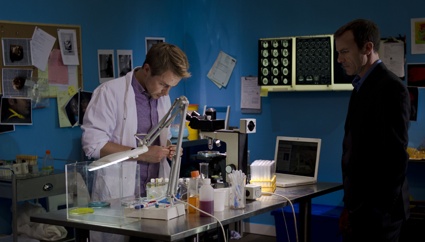
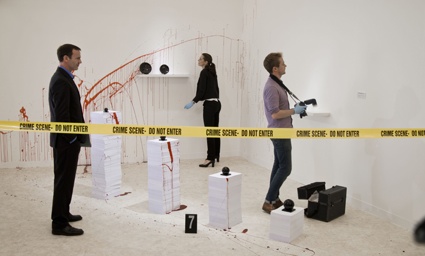 Aslı Çavuşoğlu, Murder in Three Acts, 2012. Photo: Taylan Mutaf
Aslı Çavuşoğlu, Murder in Three Acts, 2012. Photo: Taylan Mutaf
The artist interviewed by Vernissage TV
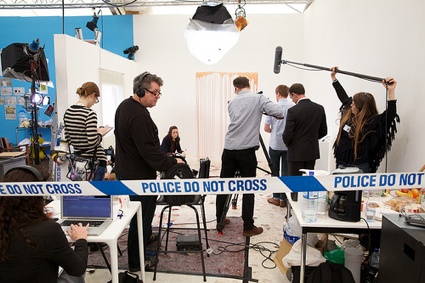
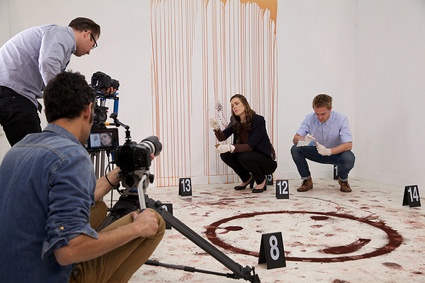 Asli Çavusoglu, Murder in Three Acts, 2012. Commissioned and produced by Frieze Foundation for Frieze Projects 2012. Photograph by Polly Braden
Asli Çavusoglu, Murder in Three Acts, 2012. Commissioned and produced by Frieze Foundation for Frieze Projects 2012. Photograph by Polly Braden
The Peter Kilchmann gallery was showing works by an artist who always gets my attention: Teresa Margolles.
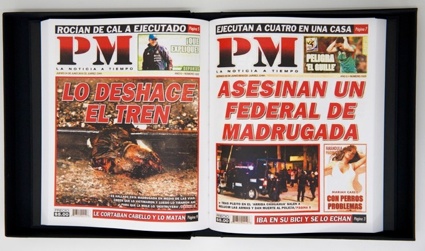 Teresa Margolles, PM, 2010
Teresa Margolles, PM, 2010
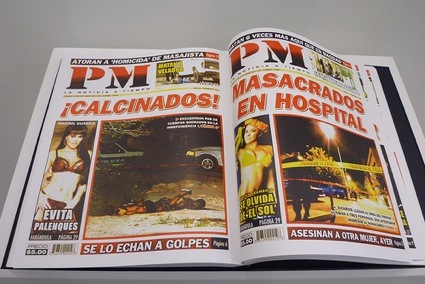 Teresa Margolles, PM, 2010
Teresa Margolles, PM, 2010
For a whole year, during 2010, Margolles collected and digitalized the covers of PM, the local newspaper from Ciudad Juárez, a city sadly renowned for the violence perpetrated by the drug cartels. Because almost everyday, somebody died a victim of the Mexican drug wars, the cover almost inevitably showed a scene of crime with a corpse right next to a pin-ups. The covers were presented as pages of a big book. Flipping through them i never realized they were real covers of tabloids. The contrast between the images was too stark, the content too relentlessly lurid. Until i read that it was a piece by Teresa Margolles, an artist who can horrify with the most mundane elements: an air conditioning system, a flag, a bracelet, etc.
This volume witnesses the collapse of the social fabric and at the same time the resilience of the community of the border city.
Interview with Teresa Margolles about the PM project during the Berlin Biennial
Her gallery was also showing photographs of trees. I didn’t find any information about the photos but i suspect the worst. Because the series is called El testigo (The Witness), i can only assume that murders took place under the cover of those trees.
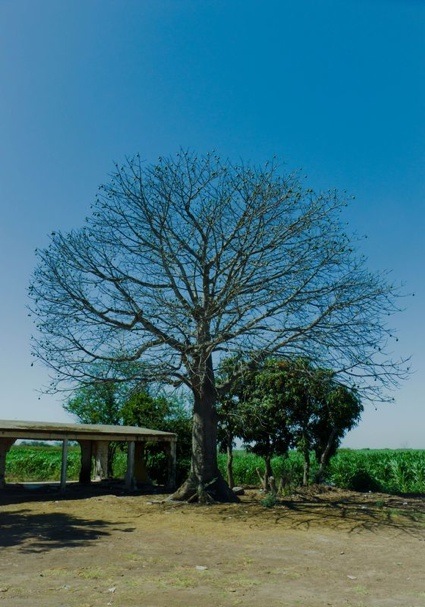 Teresa Margolles, El testigo, Ciudad Juárez, 2010 (Peter Kilchmann gallery)
Teresa Margolles, El testigo, Ciudad Juárez, 2010 (Peter Kilchmann gallery)
